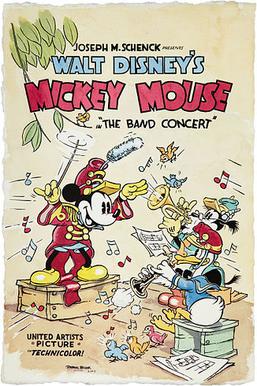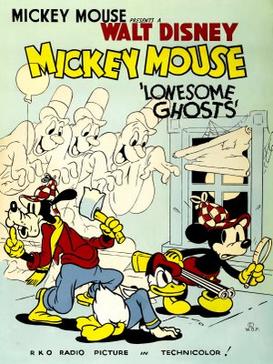
Mickey Mouse is an American cartoon character co-created in 1928 by Walt Disney and Ub Iwerks. The longtime icon and mascot of the Walt Disney Company, Mickey is an anthropomorphic mouse who typically wears red shorts, large shoes, and white gloves. He is often depicted with a cast of characters including his girlfriend Minnie Mouse, his pet dog Pluto, his friends Donald Duck and Goofy, and his nemesis Pete.

Pete is a cartoon character created by Walt Disney and Ub Iwerks of The Walt Disney Company. Pete is traditionally depicted as the villainous arch-nemesis of Mickey Mouse, and was made notorious for his repeated attempts to kidnap Minnie Mouse. Pete is the oldest continuing Disney character, having debuted in the cartoon Alice Solves the Puzzle in 1925. He originally bore the appearance of an anthropomorphic bear, but with the advent of Mickey in 1928, he was defined as a cat.

Goofy is a cartoon character created by the Walt Disney Company. He is a tall, anthropomorphic dog who typically wears a turtle neck and vest, with pants, shoes, white gloves, and a tall hat originally designed as a rumpled fedora. Goofy is a close friend of Mickey Mouse and Donald Duck, and is Max Goof's father. He is normally characterized as hopelessly clumsy and dim-witted, yet this interpretation is not always definitive; occasionally, Goofy is shown as intuitive and clever, albeit in his own unique, eccentric way.

Plane Crazy is a 1929 American animated short film directed by Walt Disney and Ub Iwerks. The cartoon, released by the Walt Disney Studios, is the first finished project to feature appearances of Mickey Mouse and Minnie Mouse, and was originally a silent film. It was given a test screening to a theater audience and potential distributors on May 15, 1928. An executive from Metro-Goldwyn-Mayer saw the film, but the film failed to pick up a distributor. Later that year, Disney released Mickey's first sound cartoon, Steamboat Willie, which was an enormous success; Plane Crazy was officially released as a sound cartoon on March 17, 1929. It was the fourth Mickey film to be given a wide release after Steamboat Willie, The Gallopin' Gaucho and The Barn Dance (1929).

Minnie Mouse is an American cartoon character created by the Walt Disney Company. As the longtime sweetheart of Mickey Mouse, she is an anthropomorphic mouse with white gloves, a red or pink bow, blue polka-dotted dress, white bloomers and yellow low-heeled shoes occasionally with ribbons on them.

Clarabelle Cow is a cartoon character created by The Walt Disney Company. As an anthropomorphic cow, Clarabelle is one of Minnie Mouse's best friends. She was once depicted as the girlfriend of Horace Horsecollar, although now she is often paired with Goofy.

The Mickey Mouse universe is a fictional shared universe which is the setting for stories involving Disney cartoon characters, including Mickey and Minnie Mouse, Donald and Daisy Duck, Pluto and Goofy as the primary members, and many other characters related to them, being most of them anthropomorphic animals. The universe originated from the Mickey Mouse animated short films produced by Disney starting in 1928, although its first consistent version was created by Floyd Gottfredson in the Mickey Mouse newspaper comic strip. Real-world versions also exist in Disneyland and Tokyo Disneyland, called Mickey's Toontown.

The Band Concert is a 1935 American animated short film produced in 3-strip Technicolor by Walt Disney Productions and released by United Artists. The 73rd short film in the Mickey Mouse series, it was the second release of the year, and notable as the first in the series to be produced in color.

Runaway Brain is a 1995 American animated comedy horror short film produced by Walt Disney Feature Animation. Featuring Mickey Mouse and Minnie Mouse, the short centers on Mickey attempting to earn money to pay for an anniversary gift for Minnie. He responds to an advertisement to work for Doctor Frankenollie, only to find out that he is looking for a donor to switch brains with the monster he created. Featuring animation by animator Andreas Deja, it was first released in 1995 attached to North American theatrical showings of A Kid in King Arthur's Court and in 1996 attached to international theatrical showings of A Goofy Movie. It would be the final original Mickey Mouse theatrical animated short until Get a Horse! in 2013.

Mickey's Toontown is a themed land at Disneyland and Tokyo Disneyland, two theme parks operated by Walt Disney Parks & Resorts and The Oriental Land Company respectively. At Tokyo Disneyland, this land is named Toontown. A similar land existed at the Magic Kingdom until 2011 and was named Mickey's Toontown Fair. Walt Disney Studios Park in Disneyland Paris has a related land called Toon Studio.
Fantasy in the Sky was the first fireworks performance at Disneyland in Anaheim, California, beginning in 1958 and running until 1996. The show also appeared at the Magic Kingdom in Lake Buena Vista, Florida from 1971 until 2003, at Tokyo Disneyland in Urayasu, Chiba, Japan from 1983 until 1988 and at Disneyland Paris from 1993 to 2005 in Marne-la-Vallee, France.

The Mickey Mouse Revue was an indoor audio-animatronic stage show at the Magic Kingdom and Tokyo Disneyland theme parks. It was one of the three original opening day attractions in Magic Kingdom's Fantasyland in 1971. After closing at Magic Kingdom in 1980, it was moved to Tokyo Disneyland for that park's opening in 1983 where it remained for 26 years before closing permanently in 2009.

Lonesome Ghosts is a 1937 Disney animated cartoon, released through RKO Radio Pictures on Christmas Eve, three days after Snow White and the Seven Dwarfs (1937). It was directed by Burt Gillett and animated by Izzy (Isadore) Klein, Ed Love, Milt Kahl, Marvin Woodward, Bob Wickersham, Clyde Geronimi, Dick Huemer, Dick Williams, Art Babbitt, and Rex Cox. The short features Mickey Mouse, Donald Duck & Goofy as members of The Ajax Ghost Exterminators. It was the 98th short in the Mickey Mouse film series to be released, and the ninth for that year.

Mickey's PhilharMagic is a 4D film attraction found at several Disney theme parks around the world, including Magic Kingdom theme park at the Walt Disney World Resort, Hong Kong Disneyland, Tokyo Disneyland, Disneyland Park (Paris), and Disney California Adventure. The film was directed by George Scribner, who also directed Disney's 1988 animated film Oliver & Company. Mickey's PhilharMagic is a 12-minute-long show featuring 3D effects, scents, and water, as well as a number of characters from Disney movies. It is shown on the largest purpose-built 3D screen ever made, at 150 feet wide.

Fantasia is an American media franchise owned by The Walt Disney Company that commenced in 1940 with the theatrical release of the film of the same name.

Roger Rabbit is a fictional animated anthropomorphic rabbit. The character first appeared in author Gary K. Wolf's 1981 novel, Who Censored Roger Rabbit?. In the book, Roger is second banana in a popular comic strip, "Baby Herman". Roger hires private detective Eddie Valiant to investigate why his employers, the DeGreasy Brothers, have reneged on their promise to give Roger his own strip. When Roger is found murdered in his home, Valiant sets out to look for the killer, with the help of Roger's "doppel".
"Mickey's 50" is a 1978 television special honouring the 50-year anniversary of the debut of Walt Disney's animated character Mickey Mouse. The show aired on NBC on November 19, 1978, one day after Mickey's official birthday, as a special 90-minute edition of The Wonderful World of Disney.















